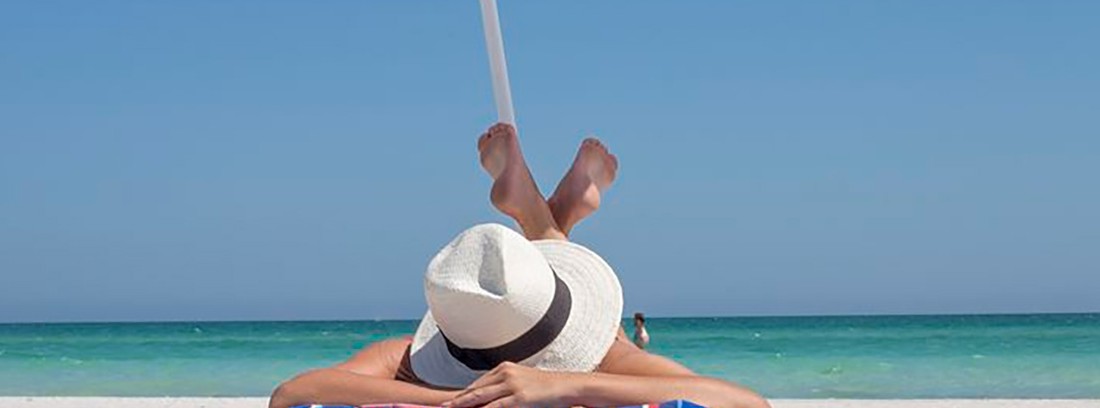The sun, always with caution

In summer the most important thing is to have a lot caution with the sun. Beach, heat, baths, rest are words closely linked to holidays, but high temperatures, the change in eating habits and the activities carried out at these times favor the appearance of discomfort and "accidents" typical of holidays.
Therefore, now that we are approaching the summer period, it is convenient to know those risks that increase during this time, so that, following some basic recommendations, avoid that a few happy days of rest and enjoyment can become a "torment".
Most of the summer "dangers" are related to high temperatures and exposure to, although fungi, gastroenteritis and insects also do their "August" during this period.
Burns, food poisoning, allergies, heat stroke, or digestion cuts are some of the unwanted "travel companions" that can threaten our vacations. A few simple measures of caution with the sunHe, or an adequate and timely reaction, are essential to keep them at bay and to be able to fully enjoy the summer period.
Sun rays
The sun is indisputably the king of the sun, and in summer it shines longer and stronger, bringing good weather and a good mood (sunlight is a natural antidepressant) and invites you to enjoy all kinds of outdoor activities (sports, baths , excursions, meals, trips ...).
But the sun can also be harmful, either through the direct effect of its rays or indirectly. We tell you how to avoid these dangers.
There are two types of solar rays that are important from the point of view of health: infrared (IR), which produce heat, and ultraviolet (UV), which, although they do not give heat, easily cause sunburn, since they are ionizing radiation that They can also cause premature aging of the skin and skin cancer, as well as cataracts and corneal opacities.
To defend itself against ultraviolet rays, the skin produces an extremely effective filter: a pigment called melanin. But only dark-skinned people have enough melanin to protect themselves from UV rays. The rest of us must apply products with a protection factor (FP).
The FP is used to calculate how much we can extend the stay in the sun, multiplying the time it takes to burn ourselves by the number of the FP. For example, if a person lasts 10 minutes and uses FP20: 10 × 20 = 200 minutes, that is, 3h and 20 ′ without burning.
Heat stroke
It is the most general, frequent and dangerous form of all accidents caused by heat and solar radiation; It generally occurs in environments with high temperature and humidity and direct sun exposure is not necessary, since it can also occur in closed places, with a hot and humid environment and in which the air flows very little.
In order to avoid heat stroke, the following measures should be taken:
- Eat moderately.
- Increase your fluid intake even if you are not thirsty.
- Avoid alcoholic and highly sugary drinks.
- Shower with warm or cool water.
- Wear light and loose clothing.
- Rest frequently in the shade.
- Keep the house cool.
- Avoid crowds.
- Exposing yourself to the sun for as little time as possible.
Children and the elderly are especially vulnerable.
The insolation
It usually occurs due to prolonged exposure to the sun, due to an excessive accumulation of heat in the body, especially in people who are not used to sunlight and who are exposed to it for a long time.
Heatstroke usually presents with a sudden headache, increased body temperature, excitement or drowsiness, nausea and vomiting, and visual disturbances, and in severe cases, breathing disorders and loss of consciousness may even occur.
To do. The first thing to do in a case of heatstroke is to lower the body temperature and in severe cases see a doctor immediately.
Sun burn
It is characterized by reddening of the skin and even blisters, with intense itching and pain, which appears a few hours after exposure to the sun and reaches its maximum after 12-24 hours.
To do. If there are blisters (second degree burn) or if the burn is extensive, see a doctor as soon as possible. In all other cases, interrupt sun exposure, apply moisturizers, drink water and other non-alcoholic beverages.
Prevention.
- Begin to sunbathe gradually.
- Always use sun protection creams (against UVA and UVB) on all areas of the skin exposed to the sun, even on cloudy days, especially in the mountains and on the beach (also under the umbrella), as well as in latitudes close to the poles.
- Apply the protective cream half an hour before going out in the sun. Repeat the operation every two hours and after each bath.
- Protect lips with high FP lip product.
- Protect your eyes with good quality polarized sunglasses (check with your optician).
- Protect the head with a cap or hat.
- Avoid exposure around noon (12 a.m. to 4 p.m.).
- Avoid exposure if taking photosensitizing or phototoxic drugs (see package leaflet or consult a doctor).
- In the sun, avoid using colognes, lotions ... that contain alcohol.
- After bathing, shower with fresh, sweet water and apply a moisturizer.
- Drink water or non-alcoholic fluids frequently. Take fruits, salads, gazpachos ...
Kids
Special caution with the sunHim: no sun for children under three years of age. Use products with FP30, without alcohol, resistant to water. Reapply periodically generously. Protect them with clothing, hats and glasses, also in the shade. Give them plenty of water to drink. Remember that sun damage is cumulative and that during the first few years sunburn can weaken the skin for life.
Pregnant
Use sunscreen with FP30 to avoid the appearance of dark spots on the skin of the face, which is known as “chloasma” and which can take time to disappear.
MAPFRE Joint Prevention Service(Updated at Apr 14 / 2024)